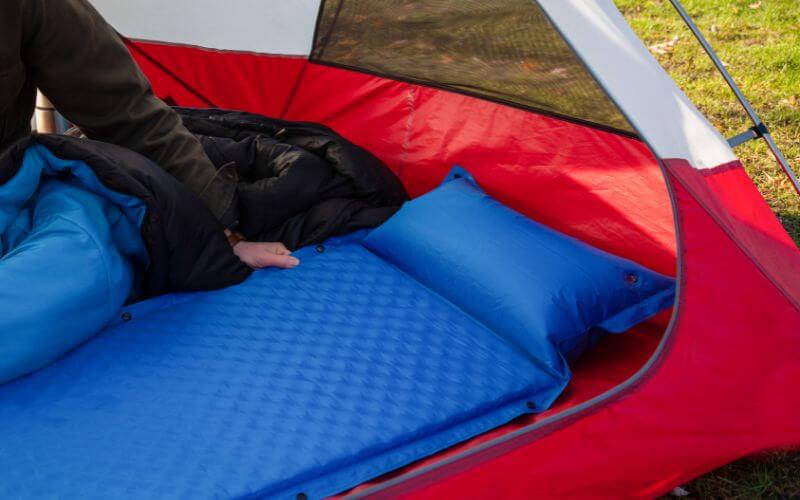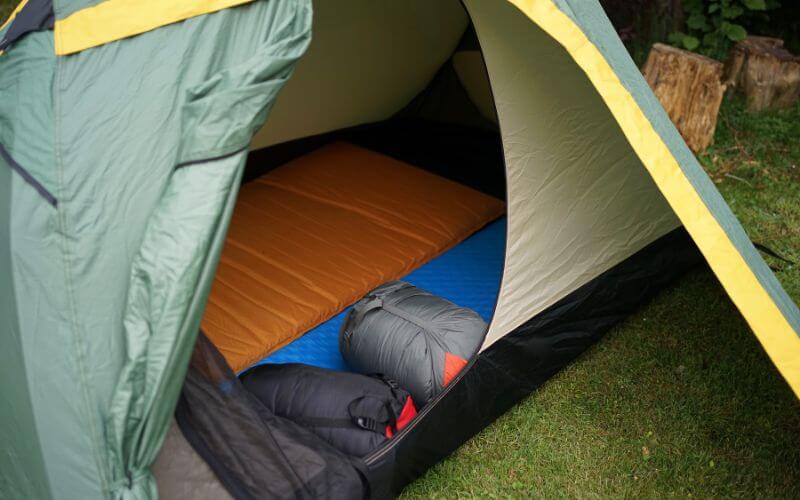Whether you’re going camping for a week or just an extended hike that’s going to need a break for a quick nap, nobody wants to sleep directly on the floor.
It’s not restful, you can never find a clear spot, and it’s bad for your posture. So you’re going to want to buy a sleeping mat.
There are a number of things to consider when buying a sleeping mat, but for the purposes of this guide, we want to compare the two main options when it comes to design – inflatable vs foam.

Why Get a Sleeping Pad?
Sleeping pads are essential if you want to get a proper rest when you’re sleeping rough.
They have two main purposes – one of which is your comfort. They offer a softer base on which to sleep, cushioning your body.
This doesn’t just feel more relaxing, it’s also better for your musculoskeletal health – lying directly on the ground normally promotes bad posture and can prevent you from properly recovering after a long hike.
The second purpose of a sleeping pad is equally important – they offer thermal insulation against the floor. Even on a mild summer’s day, the ground is relatively cool. Spend any significant amount of time on there and you’re going to lose body heat.
A sleeping mat acts as a barrier, ensuring that you retain the heat and keep yourself safe and warm.
To that end, sleeping mats are assigned an R value. The R value indicates how much thermal resistance is offered by the sleeping mat. Anything between 1.0 and 2.0 is normally fine for the summer months, but for winter you’ll want at least 4.0 and ideally above 5.0.

What is an Inflatable Sleeping Pad?
Inflatable sleeping mats are mats made from a tough, durable plastic that can be inflated to provide a comfortable mattress to lie on. They can be inflated manually, making them a good choice for portability since a pump is optional.
Inflatable sleeping pads have an R-value of between 3 and 7, thanks to the trapped air inside when they are fully inflated. This makes them a good choice for use in winter, since they will insulate your body heat better.
They are very lightweight when deflated – usually no more than 1 pound, and they will inflate to between 2-3 inches thick.
While they are a solid choice for warmth, they do have downsides. One of those is that they can puncture when laid on a rough surface.
The material they’re made from is quite thick, but even then a sharp rock can cut through.
The other downside is their comfort – when fully inflated, they can be a little less forgiving. They can be loud too as you move around, so if you tend to toss and turn in your sleep, you might be disturbed.
Make sure you get one with a soft covering as well, or during warmer nights you may end up sticking to the plastic.
What is Foam Sleeping Pad?
A foam sleeping pad is made using closed-cell foam which is dense and has tiny closed pockets that are filled with air. The air pockets help to provide some heat insulation, but they are thin and sometimes not super-comfortable.
Compared to inflatable sleeping pads with an R-value of between 3 and 7, foam sleeping pads have an R-value of between 1.5 and 2. This makes them good for summer, but not so good during colder winters.
Most foam sleeping pads roll up, making it easier for them to be strapped on a hiker’s backpack. But they still tend to be more bulky than an inflatable sleeping pad. They’re thinner too – usually around 1 inch thick.
However, they are incredibly durable compared to inflatable sleeping pads as you do not have to worry about punctures, and they’re relatively comfortable – though not super comfy due to their thinner design. They are quieter too.
Check out this popular YouTube video on choosing a sleeping pad.
How Do Inflatable and Foam Sleeping Pads Compare?
Here’s how inflatable and foam sleeping pads shape up side-by-side.
Ease of Use
Foam sleeping pads are a lot easier to use and setup than inflatable ones. You only need to unclip and unroll them, and they’re ready to go. It takes seconds. And in the morning, just roll them back up again.
With inflatable ones, you need to unroll them, and then spend a couple of minutes inflating them. And the next morning, you need to deflate them again before you can roll them back up.
The time difference isn’t huge, but the manual inflating is tricky after a long day of hiking. You can sometimes get a small battery-powered pump that doesn’t weigh a lot to help out, so that might be worth taking with you if you camp regularly.
Comfort and Warmth
When selecting the best sleeping pad, comfort and warmth should be your first priority. Inflatable pads are thicker than foam pads, and so most people find them more comfortable, though it can vary.
One of the benefits of an inflatable sleeping pad is that you can add or remove some air to suit you – if you want a mattress with a little more give, just deflate it slightly.
Additionally, inflatable pads are warmer as they have a higher R-value than foam pads. Inflatable pads have an R-value of between 3 and 7 compared to foam pads with an R-value between 1-2.
Because of their excellent thermal insulation, inflatable pads are perfect in cold weather compared to foam pads. With thermal insulation of 2 or less, foam pads will require extra insulation material underneath them in cold weather.
Convenience and Weight
Inflatable sleeping pads fold up well and can fit inside your backpack. Some models of inflatable pads can even fit in the mesh pocket on the side of your backpack.
Foam pads are larger, and can’t fit into a backpack. Most foam sleeping pads measure around 20 inches long by 6 inches in diameter when packed.
When packed inside a backpack, they occupy a large space, reducing the backpack capacity to carry other necessary items.
So they’re usually strapped to the outside of the backpack. The strapping on the outsides also means that you are stuck with the entire width, making tight squeezes on the trail troublesome.
Most campers find foam sleeping pads more convenient at night compared to an inflatable sleeping pad. Foam pads suppress sound, making them an excellent choice for sleepers who move around a lot in their sleep.

Durability
In terms of durability, foam sleeping pads are better. It is highly likely for an inflatable sleeping pad to get punctured by a thorn, sharp sticks, or rocks.
The worst thing is that if your pad gets punctured, it immediately deflates. Although some sleeping pads have a patch kit, deflation at night causes major discomfort.
Repairing a puncture can be stressful, especially if the puncture is small, because you will have to locate it by inflating the sleeping pad, applying the patch, waiting for it to dry, and then inflate it again. Now imagine looking for a puncture hole in the middle of the night – it can be a pain in the butt.
To reduce the risk of a puncture, it is important to ensure that the campsite is extremely clear of thorns or any sharp object.
With foam sleeping pads, you don’t need to worry about punctures.
Therefore, in terms of durability foam sleeping pads are the best, and they give you that peace of mind while sleeping to maximize muscle recovery and mental stability.
Value
A foam sleeping pad provides more value compared to an inflatable sleeping pad. Apart from using a foam pad as a mattress, it can also double as a seat pad.
The only thing you need to do is unstrap it and lay it over a rock or any inclined area you feel comfortable with.
This comes in handy when you want to relax and watch the sunrise or sunset while having a snack.
It is almost impossible to use an inflatable sleeping pad as a seat pad due to the risk of puncture. Plus, using an inflatable sleeping pad as a seat pad means that you’ll have to inflate and deflate the pad multiple times, wasting a lot of energy.
Cost
Although both sleeping pads have pros and cons, sleeping pads remain a critical part of your camping experience. I would advise you to go for a sleeping pad that will provide comfort and warmth, but if you are on a budget, the best choice would be a foam sleeping pad.
Foam sleeping pads are cheaper than inflatable sleeping pads, with the most popular foam pads ranging between $39-50, while good-quality inflatable pads range between $80-170. You might be able to find cheaper ones, but don’t buy them – they are more prone to puncture and they’re a lot less comfortable.

Final Thoughts
Camping is an exciting experience that requires maximum comfort and stability. Therefore, your choice of a sleeping pad will play a big part in your overall camping experience.
Foam and inflatable sleeping pads have their pros and cons, but I believe that an inflatable sleeping pad maximizes your camping experience.
The bottom line is that foam sleeping pads are less costly, easy to set up, and double as sit-ups. However, inflatable pads are comfortable and warmer, lightweight, and a lot more portable. It’s close, but I think those pros for an inflatable one edges it slightly.


